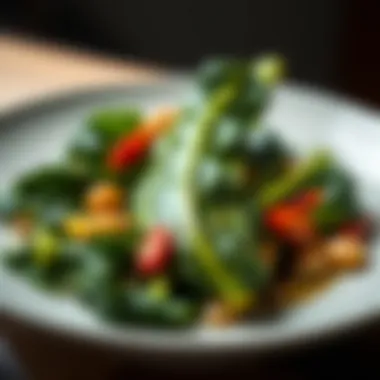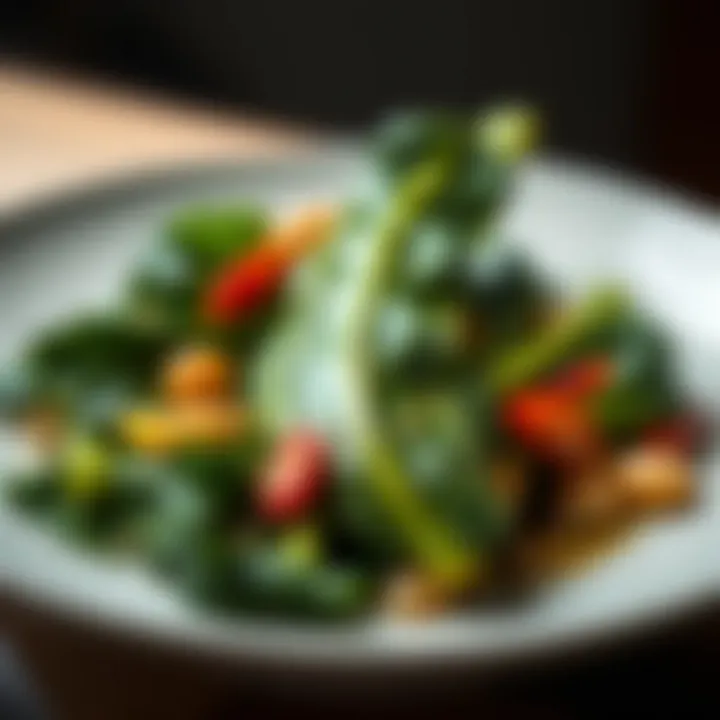Explore the Culinary Wonders of Swiss Chard


Intro
When it comes to leafy greens, Swiss chard stands out not only for its vivid colors but also for its robust nutritional profile. This vegetable, with its brightly colored ribs and broad, dark green leaves, is a powerhouse packed with vitamins A, C, and K, as well as essential minerals like magnesium and potassium. Swiss chard is not just a health food; it's a culinary delight, boasting a slightly bitter yet earthy flavor that can elevate a variety of dishes.
Often overlooked in favor of more common greens like kale or spinach, Swiss chard deserves a spotlight in your kitchen. This guide serves to demystify this leafy vegetable's culinary uses, from preparation methods to innovative ways to incorporate it into your meals while providing crucial insights on selecting, storing, and cooking Swiss chard. So whether you're planning a hearty dish or a light salad, this guide is your go-to resource for armeding yourself with knowledge on all things Swiss chard.
Foreword to Swiss Chard
Swiss chard holds a unique position in the vegetable world, not just for its striking appearance but also for its remarkable nutritional profile and culinary versatility. This leafy green often finds its way into farmers' markets and grocery stores, yet many individuals may not be fully aware of its benefits and usages in the kitchen. Developing a familiarity with Swiss chard enriches one’s culinary journey, adding depth to meals and promoting a healthier lifestyle.
What is Swiss Chard?
Swiss chard is a member of the beet family, known scientifically as Beta vulgaris var. cicla. Its striking green leaves are accompanied by vibrant stems, which can range from white to pink, red, or even yellow. These colorful stalks are not merely eye candy; they come packed with their own set of nutrients, making Swiss chard an all-around powerhouse.
The leaves are usually broad and glossy, displaying a rich green hue. The flavor is gentle, with a slight earthiness that pairs well with a host of other ingredients. Swiss chard can be both cooked and consumed raw, providing an adaptable ingredient for a variety of dishes, from salads to sautés.
History and Origin
Swiss chard’s history can be traced back to the Mediterranean region, particularly focusing on countries like Switzerland, which is where the name derives from. Contrary to popular belief, Swiss chard was not originally from Switzerland but rather was cultivated by the ancient Greeks and Romans, who appreciated its nutritional benefits.
Over centuries, this leafy green was brought across Europe and eventually to the Americas. It became a staple in various cuisines due to its resilience and ability to flourish in different climates. Its deep-rooted history not only illustrates its adaptability but also speaks to its longstanding significance in human diets. Today, Swiss chard can be found featuring prominently in traditional dishes around the world, showcasing its ability to blend seamlessly into various culinary traditions.
Nutritional Profile of Swiss Chard
Understanding the nutritional profile of Swiss chard is essential for anyone looking to enrich their diet with potent, healthful greens. With a vibrant and colorful presence on the plate, Swiss chard brings not only aesthetic appeal but also a treasure trove of vitamins, minerals, and health benefits that can enhance overall well-being. Integrating Swiss chard into meals can serve as a practical route to achieving a more balanced diet, especially for food lovers who appreciate the interplay of flavor and nourishment.
Vitamins and Minerals
Swiss chard excels in hosting an impressive lineup of vitamins and minerals, positioning itself among the top leafy greens. A single serving can offer a substantial portion of daily needs for several essential nutrients. Here’s a rundown of key elements:
- Vitamin K: Important for blood clotting and bone health, Swiss chard shines here. Just a cup can fulfill over 700% of the daily recommended intake!
- Vitamin A: Essential for vision and immune function, it's packed with beta-carotene, contributing to skin health as well.
- Vitamin C: Known for its role in collagen production and immune function, it may also aid in iron absorption from the chard itself.
- Magnesium and Potassium: Both help regulate blood pressure and support cardiovascular health.
- Iron: Though it's not as rich as some other leafy greens, Swiss chard still provides a fair amount, important for red blood cell production.
Each of these components plays a vital role in our daily functioning. Consuming Swiss chard regularly can be a smart addition to a nutrient-optimized diet, especially for those at risk of deficiencies in these areas.
Health Benefits
The benefits of Swiss chard stretch far and wide, touching on various aspects of health and wellness. Here are a few significant advantages that make this leafy green worth considering:
1. Antioxidant Properties: Swiss chard is high in antioxidants, substances that combat oxidative stress in the body, potentially reducing the risk of chronic diseases.
2. Bone Health: Thanks to its high vitamin K content, Swiss chard supports bone density and health, making it a key player in maintaining a strong skeletal system.
3. Diabetes Management: Some studies suggest that compounds found in Swiss chard low er the risk of diabetes. Its impressive fiber content may help in moderating blood sugar levels.
4. Heart Health: The potassium found in Swiss chard aids in regulating blood pressure, which is crucial for cardiovascular health. This, coupled with magnesium, positions Swiss chard as an ally for a healthy heart.
5. Digestive Aid: With its high fiber content, Swiss chard promotes healthy digestion and supports a balanced gut microbiome.
Incorporating Swiss chard into one's diet not only provides nutrients but also plants the seeds for a healthier lifestyle. For those concerned with specific health challenges or merely looking to enhance their nutritional intake, Swiss chard emerges as a versatile option.
With its remarkable nutritional profile, Swiss chard stands out as a multi-faceted food choice, ready to contribute to your health journey.
For more detailed information, visit the following resources:
Choosing Fresh Swiss Chard
Choosing fresh Swiss chard is an essential step that lays the foundation for a delightful culinary experience. Picking out quality produce not only enhances the flavors of your dishes but also ensures that you are striving for maximum nutritional benefits. When you opt for fresh chard from the store or farmers' market, several factors can help you identify high-quality leaves over wilted ones.
Identifying Quality Produce
When you stand in front of the vegetable display, some crucial elements come into play to help you gauge the quality of Swiss chard. Here’s what to look for:
- Color: Fresh Swiss chard leaves should exhibit a vibrant, deep green hue. The stems can range from white to bright red or yellow. Opt for more colorful stems; they often signify richer nutrient content.
- Texture: The leaves should be crisp and firm, not limp or soggy. When you feel a leaf, it should resist slightly—not crumble at your touch.
- Fullness: Look for a bunch that has plenty of leaves and stems together; sparse bunches could mean they've been sitting around too long.
- No Spots: Avoid leaves with brown spots or signs of decay, which can indicate poor storage or shelf life issues.


A common practice among seasoned shoppers is to take a closer look at the stems. If they are vibrant and upright, it’s a sign of freshness. Whereas, stems that look too soft or desaturated are typically a mark of age.
"The freshness of your ingredients is half the battle won in the kitchen."
Seasonality
Understanding when Swiss chard is in season is equally important, ensuring that you're likely to get the freshest produce available. Generally, Swiss chard thrives in cool weather, making it a popular choice in spring and fall. Depending on your location, here’s a quick rundown:
- Spring Harvest: If you’re in a temperate region, you'll find Swiss chard starting to shine as the weather warms up, typically around April.
- Fall Harvest: In many areas, you can enjoy another wave of fresh chard from late summer into early fall.
Not only does seasonal produce tend to taste better, but it’s usually more affordable and eco-friendly as well. This approach not only makes culinary sense but also supports local farmers, reducing the carbon footprint associated with long-distance produce transportation.
By keeping an eye on these crucial aspects of selecting Swiss chard, you can enhance your kitchen skills immeasurably, making for a tastier and healthier experience overall.
Preparing Swiss Chard for Cooking
Preparing Swiss chard properly can make or break your cooking experience with this vibrant green. Its leaves and stems are packed with flavor and nutrients, but they require a bit of attention before they shine on your plate. You cannot just dive in without a little prep work, otherwise, the results might not highlight the best this veggie has to offer. Addressing how to clean, wash, trim, and chop the Swiss chard is essential for ensuring that your culinary efforts are rewarding and enjoyable.
Cleaning and Washing
Before you toss those lovely chard leaves into a pan, you have got to give them a good wash. Swiss chard, much like other leafy greens, often has dirt and grit clinging closely. This can be an unwelcome surprise when you take a bite. To start off, rinse the leaves under cold running water. It helps to gently separate the leaves to let the water do its job. You may notice that if you shake them a bit, the remnants of dirt will loosen up.
Here’s a good approach:
- Fill a bowl with cold water. Submerge the chard and swish it around.
- Let it soak for a few minutes. Dust and dirt will sink to the bottom.
- Lift the chard out. Don’t dump the water and risk getting the dirt back on the leaves.
- Final rinse. A quick wash under cold water ensures they are squeaky clean.
Now, grab a towel to dry them off. While you might be eager to jump into cooking, taking this step is vital. You don’t want water splashing around in your skillet, or worse, steaming your chard instead of sautéing it!
Trimming and Chopping Techniques
Once clean, the next step is to trim and chop the chard in a way that suits your recipes. The stems of Swiss chard can be a bit tougher than the leaves, but they are also flavorful. Deciding whether to keep them in your dishes will depend on what you’re making.
- Trimming the ends: Use a sharp knife to cut off the bottom inch or so of the stem. If the outer parts are looking wilted or dried out, those need to go too.
- Separating the stems and leaves: This is where it gets interesting. If you’re making a dish where you want to use both parts, slice the stems into small pieces. They’ll need a few extra minutes cooking time compared to the leaves, which can be added later.
- Chopping the leaves: For the leaves, a simple cross-cut down the middle of each leaf, followed by slicing across into strips or smaller pieces works well. This keeps everything nicely bite-sized.
"A little prep upfront can save a lot of hassle later on."
Your chopping style can also depend on the final dish. For instance, if you plan to toss the chard into a stir-fry or pasta, smaller pieces might work best, while larger strips could be suited for salads or steaming.
Taking the time to correctly clean and chop Swiss chard not only enhances the taste and texture of any dish, but it also shows you respect the ingredients at hand. This step is just as important as the final cooking methods, setting the stage for the flavors to really pop.
Cooking Methods for Swiss Chard
Understanding the various cooking methods for Swiss chard is vital for getting the most from this nutritious vegetable. Each method brings out different flavors and textures, allowing you to experiment with your culinary skills. Whether you're looking to preserve the vegetable's bright color and vital nutrients or enhance its natural taste, the right cooking technique can elevate your dish to new heights.
Sautéing
Sautéing is among the quickest and most efficient ways to cook Swiss chard. It allows for a delicate balance between cooking the greens and retaining their vibrant color. The method essentially involves cooking the chard with a bit of oil over medium heat, often alongside garlic or onion for added flavor. In just a handful of minutes, you can transform Swiss chard into a tender and flavorful side dish.
The beauty of sautéing lies in its versatility. You can toss in a splash of lemon juice, sprinkle with chili flakes, or even add some nuts for crunch. Not only does this method save time, but it also preserves a good chunk of the vegetable’s nutritional value—think vitamins A and K, which easily degrade with prolonged heat exposure.
Steaming
When it comes to steaming Swiss chard, the method shines as it retains most of the greens' nutrients while softening the leaves. This method works by briefly exposing the chard to steam, effectively cooking it without submerging it in water. This way, the vibrant green hues stay intact, and you enjoy the natural flavors without loss.
To steam chard, you simply set it over boiling water for about three to five minutes. The leaves will wilt, yet keep that fresh character. This method is great if you're planning to toss the chard into a salad or serve it alongside grilled proteins, as it introduces a tender texture without overpowering flavors.
Braising
Braising is another intriguing method worth exploring when it comes to Swiss chard. Unlike sautéing, braising involves slow cooking in a bit of liquid which enables the flavors to blossom beautifully over time. This method works particularly well for the thicker stems of Swiss chard, lending them a wonderful softness and depth of flavor.
You could start by sautéing onions, adding the chard stems, then finish with greens and a splash of vegetable or chicken broth, letting it simmer gently. The result? A rich and satisfying dish that pairs wonderfully with grains or proteins. It’s an excellent way to use the chard’s full spectrum, from leaf to stem, ensuring nothing goes to waste.
Raw Preparations
Don’t overlook the possibility of enjoying Swiss chard raw! Despite its reputation as a cooking green, when treated right, it can make a fabulous addition to salads or wraps. Raw Swiss chard has a crisp texture and slightly peppery taste that can bring a refreshing crunch to your meals.
To prepare it raw, just make sure to wash it thoroughly, remove the tough stalks, and slice or chop it into bite-sized pieces. You can pair it with vinaigrettes, citrus dressings, or mix it in a bowl with other veggies and nuts. It’s not only a healthy addition but an attractive one too, adding a burst of color to your plate.


"Swiss chard is more than just a leafy green; it’s a canvas for creativity in the kitchen."
In summary, choosing the right cooking method for Swiss chard can make all the difference between a bland dish and a remarkable one. Each technique has its unique charm, depending on what you aim to achieve, ensuring this versatile vegetable holds a well-deserved spot in your culinary arsenal.
Incorporating Swiss Chard into Meals
Swiss chard is not just a garnish or an optional addition; it's an extraordinary powerhouse of flavor and nutrition that can elevate various dishes. Understanding how to fold this leafy green into meals allows us to reap the benefits of its rich vitamins while exploring countless culinary avenues. Eating Swiss chard can transform mundane routines into delightful and vibrant dining experiences. Here, we will dissect specific ways to make Swiss chard an essential part of your meals.
In Salads and Wraps
Swiss chard leaves can be a wonderful substitute for traditional lettuce in salads, adding depth with their slightly earthy flavor. When selecting Swiss chard for salads, opt for young, tender leaves that are vibrant in color, indicating freshness.
Try mixing chopped Swiss chard with fresh tomatoes, cucumbers, and a light vinaigrette for a refreshing summer salad. You can also toss in some avocado for creaminess and walnuts for crunch. Wraps are another brilliant way to use Swiss chard. Instead of using tortillas, consider leaving a large Swiss chard leaf unbroken as a wrap. Fill it with grains like quinoa, grilled chicken, or roasted veggies for a nutritious lunch that stands out.
In Soups and Stews
Incorporating Swiss chard into soups and stews not only boosts the nutrition but also brings a lovely texture to the dish. When added to hearty stews, Swiss chard holds its shape while providing ample nutrients. Mid-way through cooking a vegetable or bean soup, toss in chopped Swiss chard. This addition transforms your bowl into a nourishing powerhouse while adding a splash of color.
Moreover, Swiss chard is an ideal candidate for green soups. A simple blend of sautéed onions, garlic, and potatoes can serve as a base, only to be brightened with freshly added greens.
"Leafy greens like Swiss chard contribute essential nutrients and elevate the overall taste of soups, creating harmony with bold flavors."
In Pasta and Grains
Pasta dishes benefit significantly from the inclusion of Swiss chard. When combined with pasta, it adds a nutrient kick that complements the starch well. Consider sautéing garlic in olive oil, adding chopped Swiss chard until wilted, and mixing it with your favorite pasta. A pinch of red pepper flakes can enhance the dish, bringing a beautiful heat that works with the greens.
For grains, Swiss chard can be stirred into risottos or pilafs. Its flavor pairs well with grains like farro or barley, providing a robust and earthy balance. Cook the grains according to package instructions, mix in sautéed Swiss chard towards the end, and finish off with a sprinkle of parmesan for a fulfilling meal.
Flavors that Pair Well with Swiss Chard
Understanding the flavors that complement Swiss chard can transform a simple dish into a culinary masterpiece. Swiss chard has a slightly earthy, mildly bitter taste, which makes it a versatile green that can adapt to a variety of ingredients. The right pairings can enhance its unique flavor, creating a harmonious dish that tantalizes the taste buds. In this section, we’ll dive into two essential categories: herbs and spices, as well as proteins and dairy. These combinations not only heighten the flavor of Swiss chard but also enrich the overall meal experience.
Herbs and Spices
In any dish, herbs and spices can be the beating heart, and Swiss chard is no exception. Here are some standout pairings to consider:
- Garlic: A quintessential companion, garlic introduces a robust flavor that melds beautifully with the slight bitterness of Swiss chard.
- Nutmeg: Just a pinch of nutmeg can add depth and warmth, especially in creamy preparations like soups or gratins.
- Thyme: This herb contributes an herby note that complements Swiss chard’s earthiness while adding freshness to any dish.
- Cumin: For a bold twist, cumin offers a warm, savory profile that works well in sautéed preparations.
When using these herbs and spices, remember to start with small amounts. You can always add more, but it’s harder to mellow strong flavors once they’ve been introduced. Experiment with various combinations to find the perfect mix that suits your palate.
"The beauty of cooking lies in its creativity. When it comes to flavor pairing, don't hesitate to think outside the box."
Proteins and Dairy
Alongside herbs and spices, proteins and dairy can enhance the hearty characteristics of Swiss chard. Here are some suggestions:
- Chicken: Grilled or roasted chicken pairs well with sautéed Swiss chard, making for a satisfying meal that balances protein and greens.
- Fish: Light fish varieties, such as salmon or cod, offer a delicate contrast to Swiss chard's bold taste, especially when complemented with citrus.
- Feta Cheese: Crumbled feta brings a creamy, tangy bite that celebrates the greens' flavor while introducing a refreshing element.
- Poached Eggs: Adding a perfectly poached egg on top of a Swiss chard dish can create a delightful richness that elevates the experience.
Combining these proteins and dairy options with Swiss chard not only enhances their nutritional profile but also creates a range of textures and flavors, making meals more enjoyable.
By understanding these flavor pairings, home cooks can maximize the potential of Swiss chard in their culinary adventures. As you experiment with combinations, pay attention to how different flavors interact, and don’t be afraid to make adjustments that cater to your unique taste preferences.
Storing Swiss Chard
Storing Swiss chard properly is essential to maintain its nutrients, flavor, and texture. Knowing how to store it well can help you get the most out of your leafy greens, allowing you to enjoy them over a longer period without sacrifice to their quality. This section will guide you through both short-term and long-term storage methods, aiming to help food lovers make the best use of Swiss chard.
Short-Term Storage
When it comes to short-term storage, the key is to keep the Swiss chard fresh for as long as possible, ideally just a few days after purchase. Here are some effective methods:
- Refrigeration: The fridge is where Swiss chard belongs for short-term stays. Wrap the chard in a damp paper towel, then place it in an open plastic bag. This method allows for moisture retention while ensuring air can circulate, preventing the dreaded sliminess.
- Prep Ahead: If you're planning to use it soon, trim and wash the leaves, then store them in an airtight container with a little bit of water at the bottom. This method keeps them crisp and ready for your next recipe.
By following these steps, you can ensure that your Swiss chard retains its vibrant color and nutrients while waiting for you to transform it into a delicious meal.
Long-Term Storage Options
If you’re looking to store Swiss chard for an extended period, it is important to take a different approach. Here are a couple of reliable long-term storage methods:


- Freezing: To freeze Swiss chard, start by cleaning it thoroughly. Blanching for about 2-3 minutes in boiling water helps retain color and nutrients, then plunge the chard into ice water for quick cooling. After draining well, package it in freezer bags, squeezing out as much air as possible. This way, it can last for up to a year!
- Dehydrating: Another option is to dehydrate the chard. Cleaning and chopping it into smaller pieces makes it suitable for this method. Use a dehydrator or an oven set to low heat, and after achieving a crunchy texture, store it in an airtight container. Dehydrated Swiss chard is excellent for soups or as a nutrient booster in various dishes.
Taking careful steps in long-term storage allows you to enjoy Swiss chard beyond its fresh phase. You can add this versatile green to your cooking whenever the mood strikes without rushing to the store.
Innovative Ways to Enjoy Swiss Chard
Swiss chard is more than just a side vegetable that suggests a salad. It’s a versatile green that can add a unique flair to various dishes, enticing even the most discerning palates. The essence of this section is not just about cooking; it’s about creativity. Exploring innovative uses for Swiss chard allows both novice cooks and seasoned culinary enthusiasts to break the mold and delight in fresh tastes and textures. Incorporating Swiss chard in different forms can enhance the nutritional value of meals and provide a delightful shift from the mundane.
In Smoothies
Creating a smoothie with Swiss chard can infuse your drink with a burst of nutrients. Unlike the robust taste of kale, Swiss chard offers a milder flavor, mixing well with fruits. When added to a smoothie, it becomes an unassuming powerhouse. Here’s how to incorporate it:
- Blend Smartly: Pair Swiss chard with sweet fruits. Bananas and berries work wonders, masking any vegetable taste while adding creaminess.
- Keep It Fresh: Use young or tender leaves for a smoother blend; older leaves tend to be tougher and less palatable.
- Experiment with Add-Ins: Consider chia seeds or protein powder to boost the protein content in your smoothie. A spoonful of peanut butter can also complement the earthy flavor of the chard.
"A smoothie is often seen as a drink for breakfast or a quick snack; adding Swiss chard elevates it to a nutritious meal option."
For a simple recipe, combine 1 cup of chopped Swiss chard, 1 banana, a handful of frozen strawberries, and one cup of almond milk in a blender just until smooth. The result is a vibrant drink that boasts health benefits without sacrificing taste.
As Chips
Turning Swiss chard into chips is a great way to enjoy this leafy green while satisfying that crunchy snack craving. The process is surprisingly simple and offers a delightful contrast to traditional potato chips. Here’s how to bring Swiss chard chips to life:
- Preparation: Start by washing and thoroughly drying the leaves. Remove the stems since they can be quite fibrous and tough.
- Season Liberally: Toss the leaves with a bit of olive oil and your choice of seasonings. Sea salt, garlic powder, or even nutritional yeast can elevate the flavors and make them addictive.
- Cooking Method: Spread the leaves in a single layer on a baking sheet and bake at 300°F for about 20 minutes, or until they are crispy. Be mindful, as they can burn easily!
The crunchiness will have you nibbling away without the guilt associated with regular chips. Plus, you get the added benefit of fiber and vitamins.
Potential Challenges and Considerations
When dealing with Swiss chard, it's essential to consider some potential challenges that could affect the enjoyment and utility of this leafy green. Even for culinary enthusiasts, Swiss chard can pose issues ranging from flavor to nutritional intricacies. Thus, understanding these challenges is a stepping stone towards enhancing one's cooking experience with Swiss chard.
Managing Bitter Flavors
One common roadblock when preparing Swiss chard is its naturally bitter taste, which can deter some people. The bitterness can stem from the plant's compounds, primarily in the leaves and stems. Thankfully, there are effective strategies to mitigate this flavor, making the chard more palatable.
- Blanching: This method involves briefly boiling the leaves before cooking them in other dishes. Just dunk the leaves in hot water for a couple of minutes, then quickly transfer them to ice water. This process helps remove some of the bitterness.
- Flavor Pairing: Consider using ingredients that complement or counteract bitterness. Ingredients such as garlic, onions, and acid from lemon juice or vinegar can all play a significant role in balancing the bitter notes of Swiss chard.
- Cooking Techniques: Longer cooking methods, like braising, allow the flavors to melloe more, which can soften the bitter aspects of the chard. Combining it with sweeter vegetables like carrots can also help.
Employing these techniques can vastly improve the experiences with Swiss chard, transforming what could be a hefty taste into something delightful.
Nutritional Considerations
Swiss chard is often heralded for its nutrient-density, but there are some nutritional considerations to keep in mind. It is rich in vitamins A, C, and K, along with minerals like magnesium and potassium, making it a powerhouse in any diet.
However, those who are prone to developing kidney stones may want to exercise caution, as Swiss chard contains relatively high levels of oxalates. These compounds can bind with calcium, potentially leading to stone formation.
- Moderating Intake: It’s advisable for individuals with such concerns to consume Swiss chard in moderation or try cooking it in ways that reduce oxalate content, such as boiling.
- Nutritional Balancing: Swiss chard can be an excellent addition to a varied diet but should be complemented with other sources of nutrients. Pairing it with proteins and healthy fats not only flavors up the meal but also enhances nutrient absorption.
Being mindful of these nutritional considerations ensures that Swiss chard contributes positively to health goals without introducing unnecessary risks to specific populations. Overall, understanding both the flavor and nutritional profiles allows one to fully embrace the leafy green's versatility.
"Swiss chard is indeed a culinary treasure, but like any ingredient, it requires knowledge and consideration to unlock its full potential."
For further reading on Swiss chard nutrition, you might check resources like Britannica or explore community videos on Reddit to see how others are managing these challenges.
End
Swiss chard is more than just a leafy green vegetable; it’s a powerhouse of nutrition and culinary versatility. As we bring this guide to a close, it’s vital to reflect on the significance of integrating Swiss chard into our diets. Not only does it offer a rich source of vitamins and minerals like vitamin K, A, and C, but it also contributes to overall health benefits such as supporting cardiovascular health and bolstering bone health. Its unique taste and texture can elevate a variety of dishes, making it an excellent choice for both seasoned chefs and home cooks alike.
Incorporating Swiss chard can significantly improve meal nutrition while offering creative avenues for flavor exploration. Here are some key takeaways worth considering:
- Nutritional Value: Packed with essential nutrients, Swiss chard serves as a robust addition to any meal plan.
- Culinary Applications: From raw salads to hearty soups, the cooking methods and pairings highlighted in this guide showcase its versatility.
- Accessibility: With proper storage and preparation methods detailed herein, Swiss chard can be a staple in every kitchen.
- Cultural Significance: Understanding its historical context helps appreciate the role Swiss chard plays in various cuisines around the world.
As food lovers become more conscious of their health and dietary choices, the importance of incorporating nutrient-dense foods like Swiss chard becomes clear. By making this leafy green a regular feature on our plates, we harness not only its health benefits but also its potential to enhance culinary experiences.
"In the world of greens, Swiss chard shines brightly, offering a unique balance of taste and nutrients that few can rival."
Adopting Swiss chard into everyday meals isn’t just a trend but a pathway to better eating habits and adventurous cooking. The next time you stroll through the produce aisle, consider reaching for Swiss chard, allowing yourself to explore the vibrant possibilities it brings to your culinary journey.
Reflections on Swiss Chard
Taking stock of the discussion around Swiss chard reveals a wealth of knowledge and opportunities for further exploration. Reflecting on the historical backdrop of Swiss chard illustrates how it has been a beloved green through the ages, favored for both its taste and nutritional benefits. This leafy vegetable has strengthen its foothold across various culinary traditions, drawing on the expertise of diverse cultures.
Its role in contemporary diets cannot be overstated. As individuals lean towards more plant-based and nutrient-rich options, the versatility of Swiss chard stands out remarkably. Home cooks, chefs, and nutritionists alike appreciate its ease of incorporation into meals, whether it stands alone or complements other ingredients.
Ultimately, engaging with Swiss chard isn’t merely about following a health trend; it’s about embracing a lifestyle choice steeped in flavor and nourishment. With continued education and innovation in recipes, who knows how the culinary landscape for Swiss chard will evolve? The journey doesn’t end here; rather, it invites further exploration and experimentation.







